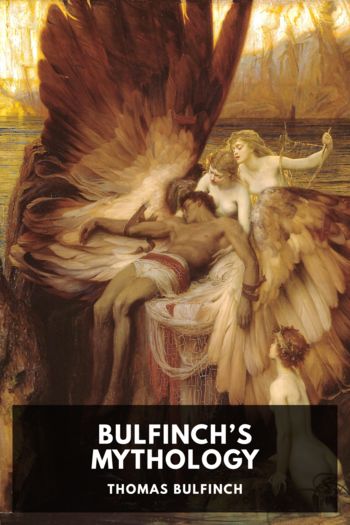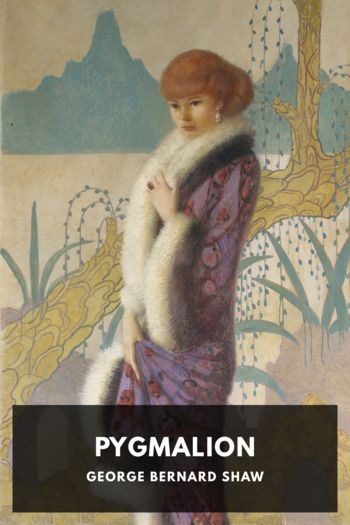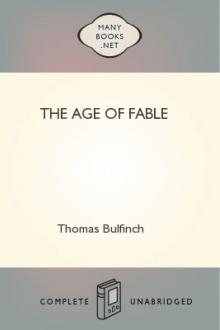Bulfinch’s Mythology, Thomas Bulfinch [love story books to read txt] 📗

- Author: Thomas Bulfinch
Book online «Bulfinch’s Mythology, Thomas Bulfinch [love story books to read txt] 📗». Author Thomas Bulfinch
Besides these two great annual festivals, the Druids were in the habit of observing the full moon, and especially the sixth day of the moon. On the latter they sought the Mistletoe, which grew on their favorite oaks, and to which, as well as to the oak itself, they ascribed a peculiar virtue and sacredness. The discovery of it was an occasion of rejoicing and solemn worship. “They call it,” says Pliny, “by a word in their language, which means ‘heal-all,’ and having made solemn preparation for feasting and sacrifice under the tree, they drive thither two milk-white bulls, whose horns are then for the first time bound. The priest then, robed in white, ascends the tree, and cuts off the mistletoe with a golden sickle. It is caught in a white mantle, after which they proceed to slay the victims, at the same time praying that God would render his gift prosperous to those to whom he had given it.” They drink the water in which it has been infused, and think it a remedy for all diseases. The mistletoe is a parasitic plant, and is not always nor often found on the oak, so that when it is found it is the more precious.
The Druids were the teachers of morality as well as of religion. Of their ethical teaching a valuable specimen is preserved in the Triads of the Welsh Bards, and from this we may gather that their views of moral rectitude were on the whole just, and that they held and inculcated many very noble and valuable principles of conduct. They were also the men of science and learning of their age and people. Whether they were acquainted with letters or not has been disputed, though the probability is strong that they were, to some extent. But it is certain that they committed nothing of their doctrine, their history, or their poetry to writing. Their teaching was oral, and their literature (if such a word may be used in such a case) was preserved solely by tradition. But the Roman writers admit that “they paid much attention to the order and laws of nature, and investigated and taught to the youth under their charge many things concerning the stars and their motions, the size of the world and the lands, and concerning the might and power of the immortal gods.”
Their history consisted in traditional tales, in which the heroic deeds of their forefathers were celebrated. These were apparently in verse, and thus constituted part of the poetry as well as the history of the Druids. In the poems of Ossian we have, if not the actual productions of Druidical times, what may be considered faithful representations of the songs of the Bards.
The Bards were an essential part of the Druidical hierarchy. One author, Pennant, says, “The Bards were supposed to be endowed with powers equal to inspiration. They were the oral historians of all past transactions, public and private. They were also accomplished genealogists,” etc.
Pennant gives a minute account of the Eisteddfods or sessions of the Bards and minstrels, which were held in Wales for many centuries, long after the Druidical priesthood in its other departments became extinct. At these meetings none but Bards of merit were suffered to rehearse their pieces, and minstrels of skill to perform. Judges were appointed to decide on their respective abilities, and suitable degrees were conferred. In the earlier period the judges were appointed by the Welsh princes, and after the conquest of Wales, by commission from the kings of England. Yet the tradition is that Edward I, in revenge for the influence of the Bards in animating the resistance of the people to his sway, persecuted them with great cruelty. This tradition has furnished the poet Gray with the subject of his celebrated ode, the Bard.
There are still occasional meetings of the lovers of Welsh poetry and music, held under the ancient name. Among Mrs. Hemans’ poems is one written for an Eisteddfod, or meeting of Welsh Bards, held in London, May 22, 1822. It begins with a description of the ancient meeting, of which the following lines are a part:
“… midst the eternal cliffs, whose strength defied
The crested Roman in his hour of pride;
And where the Druid’s ancient cromlech frowned,
And the oaks breathed mysterious murmurs round,
There thronged the inspired of yore! on plain or height,
In the sun’s face, beneath the eye of light,
And baring unto heaven each noble head,
Stood in the circle, where none else might tread.”
The Druidical system was at its height at the time of the Roman invasion under Julius Caesar. Against the Druids, as their chief enemies, these conquerors of the world directed their unsparing fury. The Druids, harassed at all points on the mainland, retreated to Anglesey and Iona, where for a season they found shelter and continued their now dishonored rites.
The Druids retained their predominance in Iona and over the adjacent islands and mainland until they were supplanted and their superstitions overturned by the arrival of St. Columba, the apostle of the Highlands, by whom the inhabitants of that district were first led to profess Christianity.
IonaOne of the smallest of the British Isles, situated near a rugged and barren coast, surrounded by dangerous seas, and possessing no sources of internal wealth, Iona has obtained an imperishable place in history as the seat of civilization and religion at a time when the darkness of heathenism hung over





Comments (0)